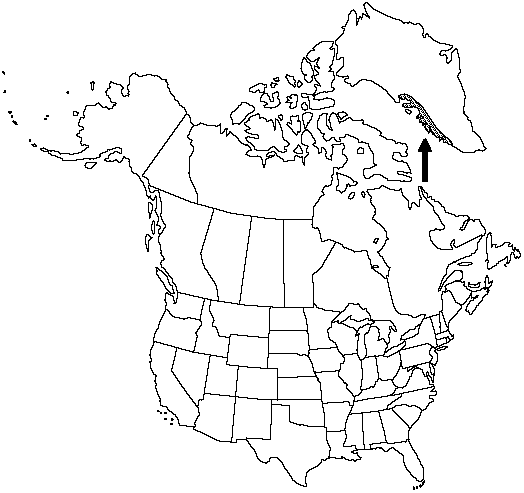Difference between revisions of "Botrychium boreale"
Bot. Zeitung 15(51): 880. 1857.
FNA>Volume Importer |
imported>Volume Importer |
||
| (7 intermediate revisions by 2 users not shown) | |||
| Line 8: | Line 8: | ||
}} | }} | ||
|common_names=Northern moonwort | |common_names=Northern moonwort | ||
| + | |special_status={{Treatment/ID/Special_status | ||
| + | |code=E | ||
| + | |label=Endemic | ||
| + | }} | ||
|basionyms= | |basionyms= | ||
|synonyms= | |synonyms= | ||
| Line 17: | Line 21: | ||
}}<!-- | }}<!-- | ||
| − | --><span class="statement" id="st- | + | --><span class="statement" id="st-undefined" data-properties=""><b>Trophophore </b>stalk sessile or nearly so; blade shiny green, ovate-deltate, 1–2-pinnate, to 6 cm, fleshy. <b>Pinnae</b> to 6 pairs, ascending, mostly overlapping, distance between 1st and 2d pinnae only slightly greater than between 2d and 3d pairs, basal pinna pair usually considerably larger than adjacent pair, obliquely rhomboidal to oblanceolate-spatulate, mostly shallowly lobed to rarely pinnate, margins entire to very narrowly shallowly crenulate, apex pointed, venation pinnate only at bases of proximal pinnae, otherwise ± like ribs of fan. <b>Sporophores</b> 1–2-pinnate, 1–1.5 times length of trophophore.</span><!-- |
-->{{Treatment/Body | -->{{Treatment/Body | ||
| + | |phenology=Leaves appearing in July and August. | ||
|habitat=Dry meadows, south-facing slopes | |habitat=Dry meadows, south-facing slopes | ||
|elevation=200–600 m | |elevation=200–600 m | ||
|distribution=Greenland. | |distribution=Greenland. | ||
| − | |discussion=<p>This well-marked northern Eurasian species is best known in Scandinavia, where it occurs most commonly with Botrychium lunaria, with which it occasionally hybridizes.</p> | + | |discussion=<p>This well-marked northern Eurasian species is best known in Scandinavia, where it occurs most commonly with <i>Botrychium lunaria</i>, with which it occasionally hybridizes.</p> |
|tables= | |tables= | ||
|references= | |references= | ||
| Line 32: | Line 37: | ||
-->{{#Taxon: | -->{{#Taxon: | ||
name=Botrychium boreale | name=Botrychium boreale | ||
| − | |||
|authority=J. Milde | |authority=J. Milde | ||
|rank=species | |rank=species | ||
| Line 39: | Line 43: | ||
|basionyms= | |basionyms= | ||
|family=Ophioglossaceae | |family=Ophioglossaceae | ||
| + | |phenology=Leaves appearing in July and August. | ||
|habitat=Dry meadows, south-facing slopes | |habitat=Dry meadows, south-facing slopes | ||
|elevation=200–600 m | |elevation=200–600 m | ||
| Line 45: | Line 50: | ||
|publication title=Bot. Zeitung | |publication title=Bot. Zeitung | ||
|publication year=1857 | |publication year=1857 | ||
| − | |special status= | + | |special status=Endemic |
| − | |source xml=https:// | + | |source xml=https://bitbucket.org/aafc-mbb/fna-data-curation/src/2e0870ddd59836b60bcf96646a41e87ea5a5943a/coarse_grained_fna_xml/V2/V2_76.xml |
|genus=Botrychium | |genus=Botrychium | ||
|subgenus=Botrychium subg. Botrychium | |subgenus=Botrychium subg. Botrychium | ||
|species=Botrychium boreale | |species=Botrychium boreale | ||
| − | |||
| − | |||
| − | |||
| − | |||
| − | |||
| − | |||
| − | |||
| − | |||
| − | |||
| − | |||
| − | |||
| − | |||
| − | |||
| − | |||
| − | |||
| − | |||
| − | |||
}}<!-- | }}<!-- | ||
-->[[Category:Treatment]][[Category:Botrychium subg. Botrychium]] | -->[[Category:Treatment]][[Category:Botrychium subg. Botrychium]] | ||
Latest revision as of 21:25, 5 November 2020
Trophophore stalk sessile or nearly so; blade shiny green, ovate-deltate, 1–2-pinnate, to 6 cm, fleshy. Pinnae to 6 pairs, ascending, mostly overlapping, distance between 1st and 2d pinnae only slightly greater than between 2d and 3d pairs, basal pinna pair usually considerably larger than adjacent pair, obliquely rhomboidal to oblanceolate-spatulate, mostly shallowly lobed to rarely pinnate, margins entire to very narrowly shallowly crenulate, apex pointed, venation pinnate only at bases of proximal pinnae, otherwise ± like ribs of fan. Sporophores 1–2-pinnate, 1–1.5 times length of trophophore.
Phenology: Leaves appearing in July and August.
Habitat: Dry meadows, south-facing slopes
Elevation: 200–600 m
Discussion
This well-marked northern Eurasian species is best known in Scandinavia, where it occurs most commonly with Botrychium lunaria, with which it occasionally hybridizes.
Selected References
None.
